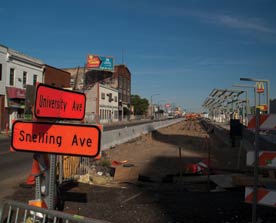During my medical residency, I once treated an asthmatic boy. It was his third hospital admission in two months. Despite specialty medical care and cutting-edge treatments, his condition worsened whenever he went home. His mom was worried that their run-down apartment, which had mold and ancient carpeting, was the problem. I remember asking the supervising physician if there was any way to write a prescription for a new apartment.
Similar cases come up in doctors’ offices and emergency rooms around the country every day. In some areas, more than 40 percent of asthma cases can be attributed to housing conditions, such as mold, pests, and carpeting. About 25 percent of American children still have unhealthy blood lead levels, primarily due to lead paint in older houses. And more than 10 million falls, burns, and other in-home injuries result in emergency-room visits every year. The costs are staggering: More than $56 billion is spent to treat asthma and more than $200 billion is spent to treat in-home injuries every year. Families with limited financial means have few options for affordable housing so they may be unable to move, even if they know their current home is making them or their children sick.
The growing field of health impact assessments (HIAs) provides a way to factor health outcomes into decisions that affect both housing and neighborhoods, such as zoning, road-building, codes, or neighborhood revitalization.
HIAs can assist decision makers in identifying unintended risks, reducing preventable illnesses and disabilities, finding practical solutions, and leveraging spending from outside the health sector to improve a community’s well-being. HIAs also provide a powerful way for communities to bring their concerns to the policymaking process.
An HIA is commonly performed by health departments or community organizations, rather than the stakeholder in charge of making the final decision. An HIA on a land use decision that will be made by a planning agency, for example, may be performed by a health department or a community coalition.
Engaging Community
HIAs engage stakeholders to improve the quality and specificity of the analysis and to help ensure that community members have a stronger voice in decisions that affect them. HIAs take an even-handed, fact-based approach that looks at both the risks and benefits of a proposal, and the community engagement process has proven to be a good way to foster a productive dialogue among polarized stakeholders. Even HIAs with relatively small budgets and short timeframes can provide opportunities for stakeholders to offer substantive input.
Community input on an HIA’s scope, findings, and recommendations can ensure that the analysis is accurate within the local context. In response to a proposal for an urban greenway, with walking and biking trails, in the East Bay along the BART a light rail corridor, for example, many community members suggested that they would be unlikely to use it because of concerns about criminal activity. This led to recommendations for design that discourages crime and better policing along sections of the greenway.
Best practices in HIAs emphasize that stakeholder engagement should go beyond simply allowing community members to voice opinions. HIAs attempt to provide substantive opportunities for community stakeholders to shape the scope of issues addressed, vet the findings, and help develop the recommendations. Some HIAs are actually led by a community group or coalition. (See sidebar.)
HIAs and Housing
While HIAs are performed across sectors, housing is becoming a common focus. The Kresge Foundation recently funded two HIAs that specifically address health and housing under the Health Impact Project’s call for proposals, and the Health Impact Project has two additional housing-related projects in the works. HIAs are being applied to a range of housing decisions, such as design, siting, affordability, and safety:
- A San Francisco Health Department HIA found that asthma patients fared better with solid flooring than with carpeting, and led to a policy that some of the new/redeveloped units in each of the city’s public housing complexes will feature hard floors.
- The Ohio Housing Finance Agency is conducting an HIA on a proposal to streamline affordable housing inspections. Those inspections are important, identifying conditions such as water leaks, mold, pests, peeling paint, and structural hazards, that can contribute to health problems such as asthma, injuries, and stress. However, several federal and state programs require their own inspections, resulting in possible redundancy. The HIA is investigating the streamlining process itself, and will recommend ways to maintain or strengthen the aspects of the current inspection regimen that are most important while still allowing for wiser use of government resources.
- Georgia State University is leading an HIA in Galveston, Texas, concerning the replacement of public housing destroyed by Hurricane Ike in 2008. The HIA will provide recommendations on both the location and design of the rebuilt units, and will take into account factors such as exposure to air pollution, crime rates, and access to amenities such as green space, grocery stores, and health care facilities.
Given the costs of illnesses related to housing, a small upfront investment in good planning has the potential to pay big dividends, both in terms of preventing illnesses and saving money. Caring for a single patient with poorly controlled asthma can cost $8,880 per year — similar to the amount it cost West Oakland Environmental Indicators project, the West Oakland Toxics Reduction Collaborative, and Human Impact Partners to complete a rapid HIA for the Jack London senior apartment complex in Oakland, Calif., near the port and several highways. Though the developer, East Bay Asian Local Development Corporation, was already sensitive to green and healthy building concerns, the HIA affected the building design, resulting in the introduction of a more comprehensive air filtration system and measures to reduce noise levels in the residences.
HIAs and Neighborhoods
HIAs have addressed not only decisions that affect housing units, but also that affect whole neighborhoods, such as new light rail lines and the accompanying development.
One HIA in Pittsburg, Calif., highlighted ways that development around a light rail stop could maximize opportunities for exercise and connect people to grocery stores, employment, and health services. It also found that the proposed development could drive up housing costs, making it difficult for residents to afford food, heat, medicines, or other necessities, and possibly displacing low-income families. Displaced people — and those left behind — may feel less engaged with their surroundings. Research shows that people who are more actively engaged in a community are more likely to walk and shop in the neighborhood, know their neighbors, and look out for one another. These benefits translate into better health outcomes. Taking this into account, the Pittsburg HIA recommended as health measures:
- designation of at least 40 percent of new units as affordable, with 16 percent for low-income households, 15 percent for very low-income households, and 9 percent for extremely low-income households;
- protection of current federally subsidized units from conversion to market rate;
- unbundling parking from the sale of units to decrease the housing cost for families who do not own cars or do not want to own cars; and
- a means-tested rental voucher program to allow more existing area residents to access the new housing.
By using the HIA, advocates were able to convince decision makers to keep an affordable housing site that had been facing opposition near the proposed station.
A Growing Tool
The use of HIAs is growing. If an upcoming decision in your community would benefit from an HIA, bring it up with policy makers, the health department, or local health advocates. Emphasize that HIAs are done within the timeline for the decision they seek to inform, and that they may be far less expensive than the consequences of failing to recognize and address potentially serious health risks.
Doctors still cannot write prescriptions to remove dusty carpeting or replace moldy drywall, but with HIAs, doctors and public health experts can work with communities to inform decisions in other fields that will help people lead healthier lives.






Comments